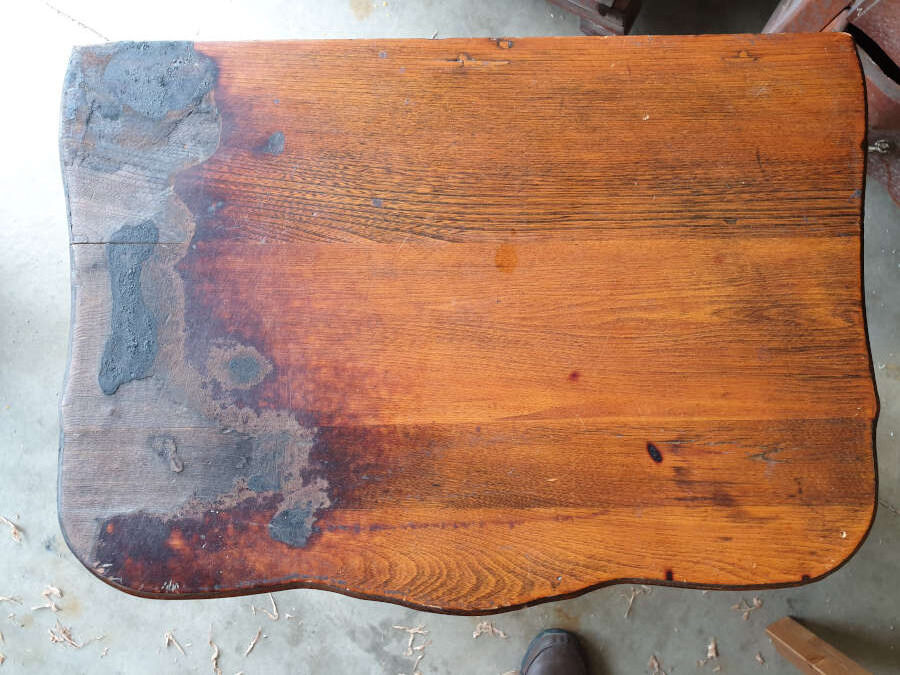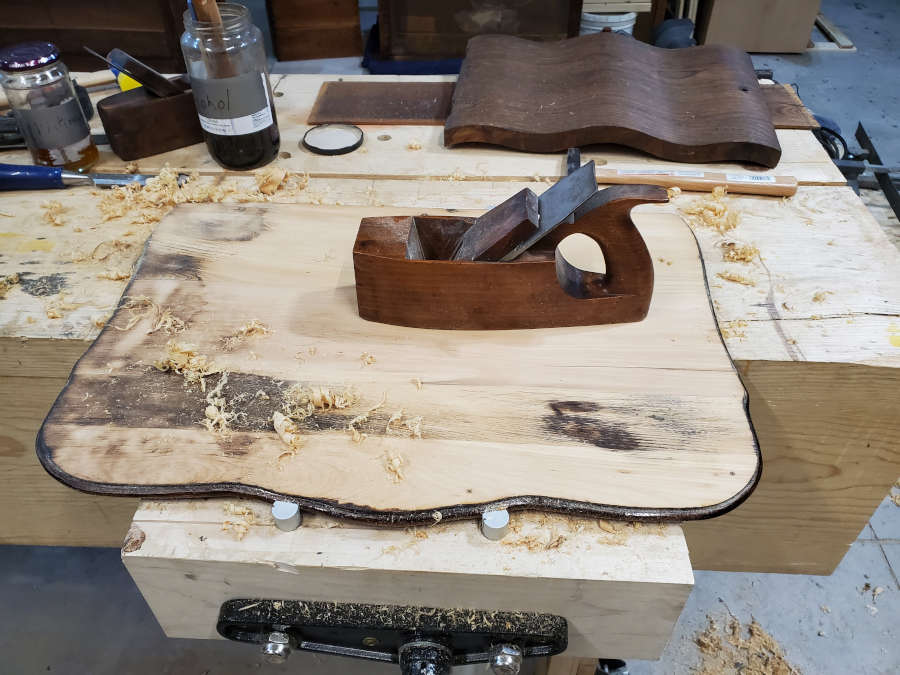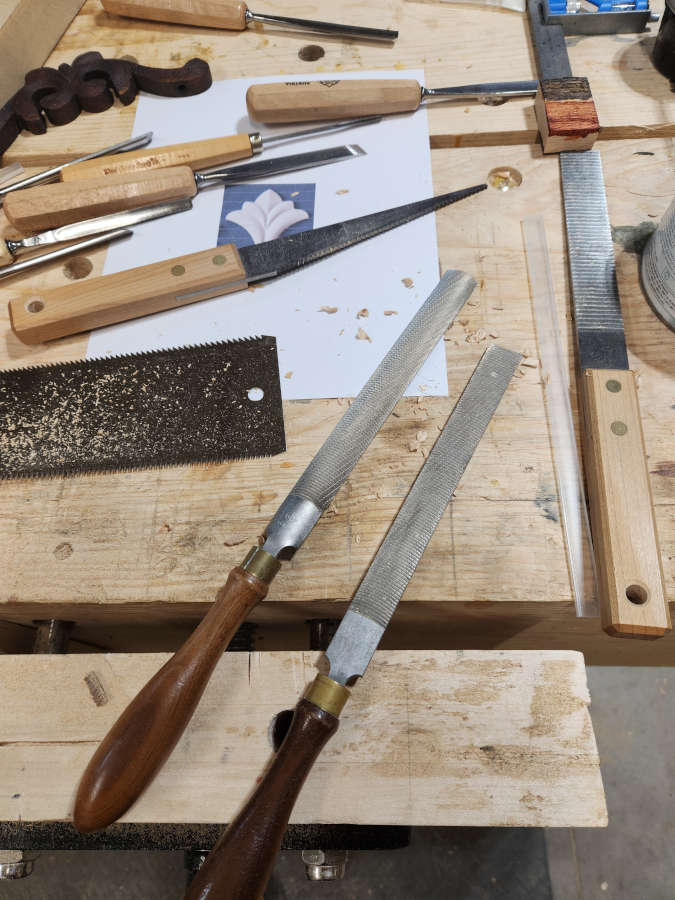Last post on this project as it is finished and ready to go back to its owners. Lots of before and after pictures, but you can find the entire process here.



Replaced all of the hardware (locks, hinges, pulls, escutcheon).






Last post on this project as it is finished and ready to go back to its owners. Lots of before and after pictures, but you can find the entire process here.



Replaced all of the hardware (locks, hinges, pulls, escutcheon).





I’ve started my next restoration projects so I’ll begin here by introducing you all to the one that’s in the worst shape. The elm stand as a whole is not in terrible shape, but the top has substantial fire damage. I’m not yet sure if the top can be repaired or if it will have to be replaced. I’m hoping I can save it.





It will get new hinges, pulls and knobs. I’ll also be replacing the casters, which are missing, with good brass and wood-wheeled casters.
The bottom is pine and is heavily warped. I doubt that I’ll put much effort into this part and will probably just replace it.


There will be some minor repairs to the feet and legs, but nothing to write home about. My next posts will cover the repairs in detail.
Part one is here.
Even though I didn’t start working on the top first, I’m going to talk about it here first because the biggest decisions I had to make about the restoration were related to the top.
First, a couple more pictures of the damage.


A few observations I made right away were that the damage was deep. I wasn’t sure how deep, but I would soon find out. The second was that the boards that make up the top were very different and there was no attempt to arrange them in a way that blended the grain. That is just a lost opportunity with something as beautiful as elm. The feathery grain is distinctive and makes it one of the most beautiful of all the woods.

I did also notice that the sides of the piece also showed the lost opportunity as the boards were not arranged for either side. I’m pretty sure this piece was made in an automated shop. Either that or the assembly line that the workers were on didn’t allow them the time to make these types of decisions.
As I looked at the fire damage, I had a couple of options running around in my head. If it was too deep I could take enough material off of the top to make it flat and then laminate some new elm on top. I could also take out material just from the portion of the top that was damaged (the left 1/3 of the top) and then laminate new material in. I dismissed this last one right away because that would have left a long line down the top where the new and old wood meet. I decided that I just did not want to introduce any new material to the top if I could help it, so I got out my hand plane and my scrapers and got to work.


After working on the top for a while, I really started to worry that the damage had simply gone too deep and that I would have to laminate material on to the top. But I did actually reach a point where I felt that the damage was not the first thing you would see.

I don’t have a lot of pictures of the colouring process, because it was more of a matter of colour matching the different boards than it was to match the top to the rest of the piece. But eventually, I got to a point where I could leave it alone and work on the rest of the piece.



I’m happy with how it’s turned out so far, and any further tweaks I feel need to be made can be done with wax.
Now on to the rest of the carcase.
Sometimes you reach a point where you feel you’ve lost all forward momentum and are stagnating. You might have a half dozen (or more) projects staring you in the face but you can’t seem to make any progress. You blame distractions, your day job, the home remodel, and any number of other possible excuses, but really you’ve hit one of your valleys.
In my case, I needed a quick win. A little project that I could get finished relatively quickly so I could then use that dopamine rush to carry me through to the rest of my projects.
And this small bookshelf was the perfect project for that.




I started by taking it all apart, which was pretty quick and easy. There were screws holding the piece together and then dowels that ran along the sides. The dowels slid out quite easily, and then the legs/stiles unscrewed from the shelves.


Once I had it apart I stripped each piece. I don’t normally strip a piece I’m working on because you lose the color and patina that many people look for in antiques. In this case, I decided to strip it because the majority of the surfaces were in bad shape and had already lost their patina and color.
I then assessed the pieces and decided that every surface needed to be sanded to get past the damage. And again, I normally don’t sand a piece I’m restoring but in this case it was already so far gone that sanding was necessary. And I’m glad I did because as I got past all of the damage and discoloration I reached some beautiful grain.
After stripping and sanding I cleaned everything with alcohol and instead of shellac, I used pure tung oil with citrus solvent. Normally I’ll use shellac, and then wax to match the color of the repaired parts and sections to the original. In this case, there was no original surface remaining so I went with

***Edit. This is the second version of this post because I had to restore the website from a backup and lost the 2nd half of this post.
I was going to keep this piece in the shop for a bit longer because there is some color variation that I could even out with a couple coats of dark wax, but I needed this project as a quick win. I needed it for the dopamine rush that I can use to continue on with my other projects. Plus we really needed a bookshelf for all of our cookbooks.





My next post will probably be on the small elm stand.
You can see my previous post here.
The color matching for the pieces was pretty straightforward. The only two colors I needed were dark walnut and red mahogany, with some dark wax to blend everything. I started with a thin coat of garnet shellac before adding the color.



When I had finished this portion, I then move onto the finial, or ornament, on the top that had broken.

I wasn’t sure what the original missing piece looked like, so I did a bit of research on acanthus leaf designs and found something that I thought would work in this case. I then printed it to scale and then transferred that to a piece of oak.



For this part of the project, I used several of my carving chisels and gouges. I also used my floats for some fast material removal and my rasps for the finer detail removal.
Once the carving was pretty much done, I colored the piece, then cut it off and glued it onto the rest of the ornament.


At this point, all that was left was to attach the ornament to the frame and put the glass back in.


This was a pretty straightforward restoration, even though it took far too long to finish.
I can’t wait to see it on the secrataire.